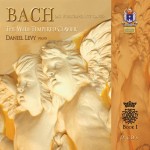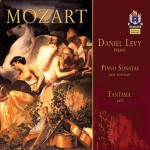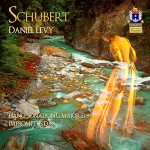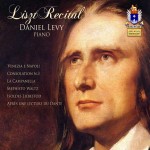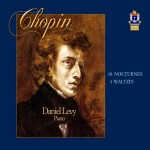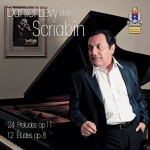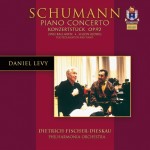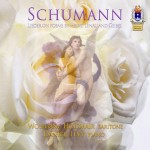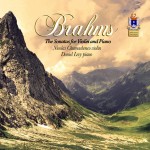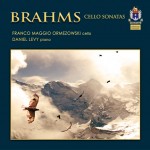DANIEL LEVY
THE VOICE OF THE PIANO, AND MORE
My first encounter with Daniel Levy came around a decade ago when I reviewed his recording of Schubert piano music for Fanfare Magazine. Back then, I suggested that his version of the G-major Sonata ranked alongside those of Alfred Brendel and Radu Lupu in what I termed “my Pantheon of treasured interpretations.” Three years later, an Edelweiss recording of the Brahms First Piano Concerto, conducted by Dietrich Fischer-Dieskau, and released together with an anthology titled “Alma Argentina” with a tango-centered program featuring pieces by Ginastera, Piazzolla, Guastavino, Ramirez, and Gardel confirmed my positive impressions. But it is only now, encountering Levy once again in this compendious collection that ranges from Bach and Mozart all the way to Debussy and Ravel, and from solo works to violin sonatas, piano sonatas, and songs, that I realize the full range–and, to venture on a too-often misused word, greatness of this remarkable musician.
It is a relatively rare pianist that can convince, and beguile, as expertly in the disciplined contrapuntal explorations of Bach as in the atmospheric musings of Liszt, the highly colored textural fantasy of Scriabin, and the imaginative genre portraits of Schumann’s songs and melodramas, but Levy triumphantly succeeds in doing so. It would be just, in responding to his two-disc traversal of The Well-Tempered Clavier, Book 1, to point to the precision of his rhythm in the C-minor Fugue, to his expert balancing of the two hands in the D-major Prelude and his unusually subtle application of the over-dotting convention in its companion Fugue, to the richly evocative color his left hand brings to the E-minor Prelude, to the incisively decided character of his A-minor Prelude and Fugue. These and many other similar observations can be made, and made accurately–but it is the poetry of his whole conception that is most important. This is romantic Bach, though only in the sense that all worthwhile music-making is romantic. Levy’s performance speaks of the human condition, and what it says both expresses and elicits deep feeling.
But again, “says” is too prosaic a word for what is going on here. Levy makes the piano sing, and he does so to equally splendid effect in every one of the nine composers generously represented in this fascinatingly varied set. For Mozart, he finds a feathery touch that yet never degenerates into mere superficiality. The drama of the first movement on the A minor Sonata is intensified by the very naked texture he fashions. The fast figures in the corresponding movement of K. 330 in C major are thrown off with stylish elan. That work’s slow movement is indeed taken more slowly than is fashionable these days, yet it never fails to flow, and the re-transition to the recapitulation in the finale is done with delicious wit.
The heaviest expressive demands in this Mozart disc come in the C-minor Fantasia and Sonata, and they also are met with poignant intensity.
The Schubert disc, comprising the G-major Sonata and the Four Impromptus, D. 899, makes a welcome reappearance in this new context. Listening to it again, I like it even better than I did on first acquaintance. The differences in dynamic shading I noted in my original review now reveal themselves as absolutely legitimate variations in the treatment of repeated material in the first two movements of the Sonata.
Few interpreters of this work can have been as meticulous as Levy in distinguishing the final 8th-note of the first movement’s seventh measure from the 16th-note in parallel passages, or in highlighting the accent on the last note of measure 129. His Andante is an affecting blend of wistful meditation with, in the fortissimo episodes, a positively granitic strength, and I particularly like the way he holds on to the chord in the eighth measure of the Menuetto for just a fraction longer than its purely mathematical value– his is rhythm conceived as a living, breathing element in music. Moments in the first of the Four Impromptus attain a visceral power suggestive of Erlkönig, and the ben marcato episode in the brilliantly characterized performance of the second Impromptu again achieves a clarity of distinction between quarter-notes (in the first measures) and 8th notes (in the eighth and ninth) that I cannot remember ever hearing so trenchantly made.
Passing next to a selection of Liszt including excerpts from the “Italy” year of his Années de pèlerinage, the Mephisto Waltz No. 1, a couple of shorter pieces, and his solo-piano arrangement of the Liebestod from Wagner’s Tristan und Isolde, we find ourselves in a vastly different emotional world. The pianist’s identification with both the afflatus and the inwardness of this Protean composer seems no less total than the Bach-ness of his Bach and the Mozart-ness of his Mozart. The sound of Venezia e Napoli and of Après une lecture du Dante (the so-called “Dante Sonata”) has an almost tactile quality, and rhythm and phrasing have just the right mercurial character. Levy’s technical command, rhythmic zest, and singing tone are evident here just as they are throughout the twelve discs in the collection, yet the differences between the expressive worlds of the composers in question–and indeed between the various works of each composer–are illuminated with the surest of hands. It would be a pleasure, by the way, to hear Levy play some of Liszt’s solo arrangements of Schubert songs, a blending of disparate compositional characters wider than that exemplified by the Wagner/Liszt melding of the Liebestod arrangement.
The familiar bracketing of Liszt with Chopin in the public mind has little to do with the actual content of the two men’s music, and it is no surprise to find Levy’s Chopin displaying as sharp a difference from his Liszt as that, in the familiar phrase, “between chalk and cheese.” A sequence of five Waltzes is played with sumptuous ease and a graceful filigree touch, and the ten Nocturnes that follow offer a broadly conceived range of expression from the sheer luxury of Op. 32 No. 1 to the juxtaposition of strangeness and steel in the tone of Op. 15 No. 3 and a rendering of the C-minor work, Op. 48 No. 1, that encompasses elegiac tone, heroic grandeur, and an explosive vehemence that is genuinely frightening. This is a Chopin far removed from the nervous ninny we too often encounter in routine performances.
Scriabin, represented by the 24 Preludes of Opus 11, the 12 Etudes of Opus 8, and another Etude without opus number, is not a composer I usually warm to. All the more credit, then, to Levy for achieving a disc that gave me much pleasure and that I often found myself smiling at. Instead of the rather amorphous harmonic soup that we find in too many Scriabin performances, the emphasis here is on tone-color and line, and particularly on the often bracing tension between lines–for once the Germanism “voice-leading,” which usually serves as a pretentious word for part-writing, seems an appropriate term. The Preludes are for the most part arresting miniature, and among the many telling touches Levy brings to them is his vivid handling of the mysterious ending of No. 10. More substantial, though never approaching the grandiosity of some of Scriabin’s splashier effusions, are the Etudes, and Levy’s performance realizes their broad range of manner and tone to perfection. Op. 8 No. 3 is done with a powerful legendary feel, No. 10 with an almost Mendelssohnian lightness. The first piece in the set evinces modest wit that is very attractive–I never thought I should be ascribing modesty to this somewhat self-aggrandizing composer!–and while No. 8 is an example of his taste for diabolism, it has a brilliance that is really overwhelming when played, as here, by a pianist with technique to burn. No. 5, suggestive of Hugo Wolf’s ironic vein, has an infection dance-like lilt, and No. 6 dances too and ends with an especially fetching little smile.
One of the most attractive discs in the set is what Levy calls “A Piano Recital for the World’s Children.” This was recorded live at a recital in Venice, except for a charmingly simple Impromptu for four hands from Schumann’s Bilder aus Osten, which Levy added in a studio performance done by overdubbing. He explains that, though there were children in the audience, the recital was not specifically for children, but that all the music he chose was inspired by and dedicated to children and childhood. Be that as it may, the technical demands of the music ensure that this recital was no child’s play for the performer, and the results attest once again to Levy’s highly impressive mastery. Along with an atmospheric reading of Debussy’s familiar La fille aux cheveux de lin, some totally unfamiliar pieces from Schumann’s Album for the Young that were collected and first published by Jörg Demus, and Liszt’s rather grandiose Hymne de l’enfant à son reveil, the program includes Schumann’s Kinderszenen, played in a way that magically evokes the elusiveness of childish thoughts and including a rapt delivery of Träumerei that is truly a reverie. Also featured is Debussy’s Children’s Corner suite, enlivened in Jimbo’s Lullaby with an effective variety of articulation and a sheer fascination with sonority, together with an apt touch of humor. Another welcome inclusion is Ravel’s Pavane pour une infante défunte, whose presence may be regarded as a semipun, since “infante” means a Spanish princess and not specifically a child; Ravel observed to one pianist who had given the piece a somnolent performance that it was meant to be a “Pavane for a Dead Princess,” not a “Dead Pavane for a Princess,” but Levy’s evocative playing runs no risk of any similar complaint. And the disc ends with the Prelude No. 1 in C major from Book 1 of The Well-Tempered Clavier, which may well have been given as a delicate and lovely encore.
Though the set is focused on the voice of the piano, it also includes contributions from two other instruments, the violin and the cello, and from two vocalists, the splendid Austrian baritone Wolfgang Holzmair and the great ex-baritone Dietrich Fischer-Dieskau, who appears not only as a speaker but also as conductor of Schumann’s Piano Concerto and Introduction and Allegro appassionato, also know as “Konzertstück.” Those two names, like those of the Russian-Polish- Argentine violinist Nicolas Chumachenco and the Polish-Italian cellist Franco Maggio Ormezowski, suffice to show the exalted circles in which Levy moves–and in which he moves on a level of complete artistic parity.
With Fischer-Dieskau and the Philharmonia Orchestra, Levy’s collaboration in the two Schumann concerted works fits like hand in glove. Aptly, his interpretation of the Piano Concerto is ruminative and discursive, quite unlike the goaloriented Brahms First Concerto that I reviewed back in 2000. The middle movement is done with song-like spontaneity, and the finale has a marvelous solidity, along with coruscating high-lying passage-work of the kind that Schumann, after his finger injury, couldn’t manage but that Clara could.
Throughout the Concerto, soloist and orchestra achieve admirably natural eloquence, and in the Konzertstück Levy’s figurations provide supple reinforcement for the romanticism of the horn solos (fine horn-playing, by the way). It was perhaps to be expected that a singer who gave as much detailed nuance to words as Fischer-Dieskau should, once he retired from singer, turn to the genre of the melodrama–spoken declamation with music. In Schumann’s Schön Hedwig and Two Ballads Op. 122, he projects the texts with consummate clarity and drama, turning the first of the Two Ballads in particular into a veritable little opera; this might almost be labeled “The Many Voices of Dietrich Fischer-Dieskau.” At times the intensity of his delivery comes close to the spirit of German Expressionism, though Levy’s always responsive playing of the piano part contributes a tone of sanity not always emulated by the more extreme of the Expressionists.
Altogether his partnership with Holzmair in a well-planned collection of Schumann songs on poems by Heine,
Lenau, and Geibel, as with Chumachenco and Ormezowski in the Brahms violin and piano sonatas, reveals a pianist as adept in the world of chamber-music as under the spotlight of solo performance. Their performances together all offer music-making of the highest standard, at once consummately and consumingly romantic, at the same time finely proportioned in structure, and reveling in the collaborative give-and-take of the Lieder and sonata worlds.
And don’t forget that Brahms, like his classical predecessors, still called these works sonatas for piano and violin and for piano and cello, rather than designating the instruments the other way round, which renders their participation in revealing “The Voice of the Piano” entirely appropriate.
Bernard Jacobson was born in London. Formerly the music critic of the Chicago Daily News and visiting professor of music at Chicago Musical College of Roosevelt University, he was The Philadelphia Orchestra’s program annotator from 1984 to 1992, serving also as musicological adviser to Riccardo Muti. He has published three books and translations from several languages, written poetry for musical setting, and performed as narrator in recordings and in concerts around the world.


